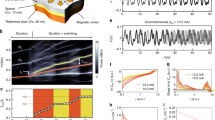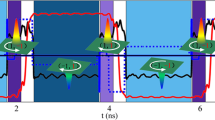Abstract
Magnetic vortices in thin films are in-plane spiral spin configurations with a core in which the magnetization twists out of the film plane1,2. Vortices result from the competition between atomic-scale exchange forces and long-range dipolar interactions. They are often the ground state of magnetic dots3,4, and have applications in medicine5, microwave generation6,7 and information storage8. The compact nature of the vortex core, which is 10–20 nm wide, makes it a suitable probe of magnetism at the nanoscale9. However, thus far the positioning of a vortex has been possible only in confined structures, which prevents its transport over large distances. Here we show that vortices can be propagated in an unconstrained system that comprises electrical nanocontacts (NCs). The NCs are used as tunable vortex attractors in a manner that resembles the propelling of space craft with gravitational slingshots. By passing current from the NCs to a ferromagnetic film, circulating magnetic fields are generated, which nucleate the vortex and create a potential well for it. The current becomes spin polarized in the film, and thereby drives the vortex into gyration through spin-transfer torques10. The vortex can be guided from one NC to another by tuning attractive strengths of the NCs. We anticipate that NC networks may be used as multiterminal sources of vortices and spin waves (as well as heat, spin and charge flows) to sense the fundamental interactions between physical objects and fluxes of the next-generation spintronic devices.
This is a preview of subscription content, access via your institution
Access options
Subscribe to this journal
Receive 12 print issues and online access
$259.00 per year
only $21.58 per issue
Buy this article
- Purchase on Springer Link
- Instant access to full article PDF
Prices may be subject to local taxes which are calculated during checkout




Similar content being viewed by others
References
Shinjo, T., Okuno, T., Hassdorf, R., Shigeto, K., Ono, T. Magnetic vortex core observation in circular dots of permalloy. Science 289, 930–932 (2000).
Tretiakov, O. A. & Tchernyshyov, O. Vortices in thin ferromagnetic films and the skyrmion number. Phys. Rev. B 75, 012408 (2007).
Mistral, Q. et al. Current-driven vortex oscillations in metallic nanocontacts. Phys. Rev. Lett. 100, 257201 (2008).
Petit-Watelot, S. et al. Commensurability and chaos in magnetic vortex oscillations. Nature Phys. 8, 682–687 (2012).
Kim, D-H. et al. Biofunctionalized magnetic-vortex microdiscs for targeted cancer-cell destruction. Nature Mater. 9, 165–171 (2010).
Pribiag, V. S. et al. Magnetic vortex oscillator driven by d.c. spin-polarized current. Nature Phys. 3, 498–503 (2007).
Jain, S. et al. From chaos to selective ordering of vortex cores in interacting mesomagnets. Nature Commun. 3, 1330 (2012).
Yu, Y-S. et al. Memory-bit selection and recording by rotating fields in vortex-core cross-point architecture. Appl. Phys. Lett. 98, 052507 (2011).
Burgess, J. A. J. et al. Quantitative magneto-mechanical detection and control of the Barkhausen effect. Science 339, 1051–1054 (2013).
Kasai, S., Nakatani, Y., Kobayashi, K., Kohno, H. & Ono, T. Current-driven resonant excitation of magnetic vortices. Phys. Rev. Lett. 97, 107204 (2006).
Devolder, T. et al. Time-resolved zero field vortex oscillations in point contacts. Appl. Phys. Lett. 95, 012507 (2009).
Ruotolo, A. et al. Phase-locking of magnetic vortices mediated by antivortices. Nature Nanotech. 4, 528–532 (2009).
Devolder, T. et al. Vortex nucleation in spin-torque nanocontact oscillators. Appl. Phys. Lett. 97, 072512 (2010).
Compton, R. L. & Crowell, P. A. Dynamics of a pinned magnetic vortex. Phys. Rev. Lett. 97, 137202 (2006).
Bauer, G. E. W., Saitoh, E. & van Wees, B. J. Spin caloritronics. Nature Mater. 11, 391–399 (2012).
Petit-Watelot, S. et al. Understanding nanoscale temperature gradients in magnetic nanocontacts. Phys. Rev. Lett. 109, 267205 (2012).
Jedema, F. J., Filip, A. T. & van Wees, B. J. Electrical spin injection and accumulation at room temperature in an all-metal mesoscopic spin valve. Nature 410, 345–348 (2001).
Kaka, S. et al. Mutual phase-locking of microwave spin torque nano-oscillators. Nature 437, 389–392 (2005).
Madami, M. et al. Direct observation of a propagating spin wave induced by spin-transfer torque. Nature Nanotech. 6, 635–638 (2011).
Petit-Watelot, S., Otxoa, R. M. & Manfrini, M. Electrical properties of magnetic nanocontact devices computed using finite-element simulations. Appl. Phys. Lett. 100, 083507 (2012).
Vansteenkiste, A. & Van de Wiele, B. MuMax: a new high-performance micromagnetic simulation tool. J. Magn. Magn. Mater. 323, 2585–2591 (2011).
Keller, M. W., Kos, A. B., Silva, T. J., Rippard, W. H. & Pufall, M. R. Time domain measurement of phase noise in a spin torque oscillator. Appl. Phys. Lett. 94, 193105 (2009).
Bianchini, L. et al. Direct experimental measurement of phase-amplitude coupling in spin torque oscillators. Appl. Phys. Lett. 97, 032502 (2010).
Acknowledgements
M.M. acknowledges J. Moonens for e-beam lithography and J. Loo and P. Neutens for scanning electron microscopy images. J-V.K., S.P.W., C.C. and T.D. acknowledge support from an the French National Research Agency through contract no. ANR-09-NANO-006 (VOICE).
Author information
Authors and Affiliations
Contributions
J-V.K., M.M. and T.D. conceived the experiment. M.M. designed and fabricated the samples. W.v.R. and L.L. supervised the device integration. T.D. and C.C. developed the high-frequency setup. M.M. and T.D. performed the measurements. S.P-W. calculated the current and field distributions. J-V.K. performed the analytical and micromagnetic modelling. T.D., M.M. and J-V.K. analysed and interpreted the data. J-V.K., M.M. and T.D. prepared the manuscript. All authors commented on the manuscript.
Corresponding author
Ethics declarations
Competing interests
The authors declare no competing financial interests.
Supplementary information
Supplementary information
Supplementary information (PDF 1484 kb)
Supplementary movie 1
Supplementary movie 1 (MP4 1499 kb)
Supplementary movie 2
Supplementary movie 2 (MP4 1572 kb)
Rights and permissions
About this article
Cite this article
Manfrini, M., Kim, JV., Petit-Watelot, S. et al. Propagation of magnetic vortices using nanocontacts as tunable attractors. Nature Nanotech 9, 121–125 (2014). https://doi.org/10.1038/nnano.2013.265
Received:
Accepted:
Published:
Issue Date:
DOI: https://doi.org/10.1038/nnano.2013.265
This article is cited by
-
Exchange-driven Magnetic Logic
Scientific Reports (2017)
-
Vortices on the move
Nature Nanotechnology (2014)



